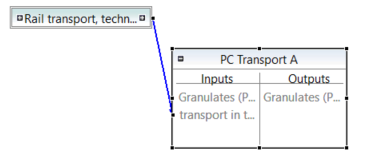Well, the best way to find out is always trying it yourself e.g. using our ‘Basic Modelling in openLCA explained using a PET bottle case study’.
If you open a process for instance ‘PC Transport A’ (from the above-mentioned tutorial) you can see the list of input flows via the Inputs/Outputs tab:

The column ‘Provider’ lists possible default providers for the respective input flows e.g. ‘transport in t*km’.

… apparently, the input flow ‘transport in t*km’ can be provided by different processes e.g. lorry transport or rail transport. You can use the dropdown menu to select the default provider for the respective input flow. In this case rail transport:

So once a default provider has been seleced, - what do the specific ‘provider linking’ categories mean?
Ignore default providers
The provider for the input flow ‘transport in t*km’ is Barge, technology mix, 1.228 t pay load capacity’. The default provider ('rail transport in t*km') has been ignored. Basically, openLCA selected the first provider that comes along.

Only link default providers
Only input flows to which a default provider has been assigned are linked to the product system. In this case, no default provider was selected for 'Granulates (PET,HDPE,PP)' so no linkage has been created.
Prefer default providers
If a default provider has been selected it will be used. If no default provider has been selected, the first process that comes along is used for linking (as in option 1).
Preferred process type
If not only default providers are to be linked, openLCA allows choosing whether unit or system processes are to be preferred. If the preferred process type does not exist, the remaining one will be selected.
Learn about the difference between system and unit processes in the following answer:
https://ask.openlca.org/53/difference-between-system-process-and-unit-process?show=601#a601